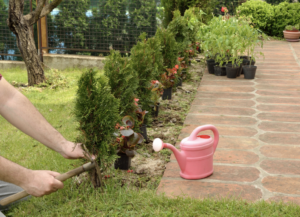Growing Food Instead of Lawns in California Front Yards
Front yards in California are transforming from standard grass lawns to vibrant microfarms, providing fresh produce for families while using significantly less water. In Los Angeles, innovative projects like Crop Swap LA are leading the charge in turning urban front yards into productive sources of organic fruits and vegetables. These mini-farms not only benefit the environment by reducing water usage but also provide a valuable food source for local communities.
One such microfarm can be found in Leimert Park, a neighborhood in South Los Angeles, where Jamiah Hargins operates a 2,500-square-foot front yard farm. What was once a typical grassy lawn is now a bustling hub of agricultural activity, growing a diverse range of crops including basil, sweet potatoes, kale, and eggplants. Through Crop Swap LA, Hargins and his team provide fresh produce to 45 nearby families, with a focus on those who may not have access to affordable, healthy food options.
The success of Crop Swap LA has fueled a growing interest in backyard farming, with a waiting list of 300 people eager to convert their yards into microfarms. Hargins, who initially started growing food for his own family, has seen the project blossom into a full-fledged non-profit organization with multiple front yard farms serving the local community. The initiative aims to empower individuals to grow their own food and promote sustainability in urban environments.
Unlike traditional lawns that require excessive watering and maintenance, these front yard microfarms are designed to be water-efficient and environmentally friendly. Hargins estimates that his farm uses 98% less water than a conventional grass lawn, resulting in lower water bills and reduced water consumption. The use of solar panels to power the farm’s irrigation system further enhances its eco-friendly credentials, making it a model of sustainable urban agriculture.
In addition to providing fresh produce for families, Crop Swap LA offers a subscription-based model where members receive a weekly bag of fruits, herbs, and veggies from the microfarms. This farm share program allows residents to support local agriculture while enjoying nutritious, locally grown produce. Priority is given to vulnerable populations, such as veterans, single parents, and low-income individuals, ensuring equitable access to fresh food within the community.
The positive impact of front yard farming extends beyond food production, fostering a sense of community and connection among neighbors. As front yards are transformed into productive gardens, they become shared spaces that bring people together and promote a sense of collective responsibility for the environment. Residents like Beverly Lofton, who converted her front yard into a small food garden named LaSalle, have found joy in contributing to a greener, more sustainable neighborhood.
Despite the many benefits of front yard farming, challenges remain in scaling up these initiatives and securing long-term funding. Crop Swap LA relies on a mix of grants, donations, and subscriptions to sustain its operations, highlighting the need for continued support for urban agriculture projects. As interest in sustainable food production grows, there is potential for front yard farming to become a widespread practice that enhances food security and environmental conservation in urban areas.
In conclusion, the shift from lawns to microfarms in California front yards represents a positive step towards a more sustainable and resilient food system. By cultivating fresh produce locally and reducing water usage, projects like Crop Swap LA are paving the way for a greener, healthier future for communities in Los Angeles and beyond. As more individuals embrace the idea of growing food instead of lawns, the potential for positive impact on public health, environmental sustainability, and community resilience continues to grow. With continued support and investment, front yard farming has the potential to transform urban landscapes and create lasting benefits for individuals and neighborhoods alike.






